The Japan Aerospace Exploration Agency (JAXA) announced that the Smart Lander for Investigating Moon (SLIM) was successfully inserted into lunar orbit at 16:51 (Japan Standard Time, JST) on December 25, 2023.
The lunar orbit of SLIM will be inserted into an elliptical lunar orbit connecting the Moon’s north and south poles with a period of approximately 6.4 hours, and altitude of about 600km at the closest point to the Moon (perilune), and 4,000km at the furthest point from the Moon (apolune). The orbit change proceeded as planned, and the spacecraft is currently in a normal condition.
From now until mid-January 2024, the apolune point will be lowered, and the orbit adjusted to a circular orbit at an altitude of approximately 600km. The perilune point will then lower and preparations for landing will begin. On January 19, the perilune point will be lowered to an altitude of 15km, and the descent towards the Moon will start at around 0:00am (JST) on January 20. Landing on the lunar surface is scheduled for around 0:20am (JST) on January 20.
SLIM is Japan’s first lunar surface mission, and aims to demonstrate precise, pinpoint lunar landing. During its descent to the Moon, the lander will recognize lunar craters by applying technology from facial recognition systems, and determine its current location from utilizing observation data collected by the SELENE (Kaguya) lunar orbiter mission. SLIM aims to soft land with an accuracy range of 100 m (330 ft). In comparison, the accuracy of the 1969 Apollo 11 Eagle lunar module was an elliptic which was 20 km (12 mi) long in downrange and 5 km (3.1 mi) wide in crossrange. According to Yoshifumi Inatani, deputy director general of the JAXA Institute of Space and Astronautical Science (ISAS), succeeding in this extremely precise landing will lead to enhanced quality of space exploration.
The expected cost for developing this project is 18 billion yen (about $150 million).
The Smart Lander for Investigating Moon (SLIM), which was launched on September 7, 2023, is currently operating smoothly.
This is a lunar lander that aims to achieve a lightweight probe system on a small scale and use the pinpoint landing technology necessary for future lunar probes. The project will aim to cut weight for higher function observational equipment and to land on resource scarce planets with an eye towards future solar system research probes.
The SLIM (Smart Lander for Investigating the Moon) project is a mission for researching the pinpoint landing technology necessary for future lunar probes and verifying this on the surface of the moon with a small scale probe.
By creating the SLIM lander humans will make a qualitative shift towards being able to land where we want and not just where it is easy to land, as had been the case before. By achieving this, it will become possible to land on planets even more resource scarce than the moon.
Six national space agencies (Interkosmos, NASA, CNSA, ISRO, JAXA and the European Space Agency) have reached the moon with uncrewed missions that achieved varying degrees of success, as well as two private/commercial missions from Israel and Japan. The Soviet Union (Interkosmos), the United States (NASA), China (CNSA) and India (ISRO) are the only four nations to have successfully achieved soft landings.
Two organizations have attempted but failed to achieve soft landings: Israeli private space agency SpaceIL with their Beresheet spacecraft, and Japanese company ispace’s Hakuto-R Mission 1.
Hiten (Japan) launched on 24 January 1990, 11:46 UTC. At the end of its mission, the Japanese lunar orbiter Hiten was commanded to crash into the lunar surface and did so on 10 April 1993 at 18:03:25.7.
The Lunar Polar Exploration Mission is a robotic space mission concept by ISRO and Japan’s space agency JAXA that would send a lunar rover and lander to explore south pole region of the Moon in 2025. JAXA is likely to provide launch service using the future H3 rocket, along with responsibility for the rover. ISRO would be responsible for the lander. ISRO, following the succes of Chandrayaan 3 also has plans to launch Chandrayaan 4, a lunar sample return mission, which would possibly be the first to return soil from the water rich south polar basin, in a landing clase to Shiv Shakthi point. The mission is planned by late 2028. Both nations are also active participants in the Artemis program
SELENE (Japan) or Kaguya after successfully orbiting the Moon for a year and eight months, the main orbiter was instructed to impact on the lunar surface near the crater Gill at 18:25 UTC on 10 June 2009. SELENE or Kaguya was launched on 14 September 2007.

Brian Wang is a Futurist Thought Leader and a popular Science blogger with 1 million readers per month. His blog Nextbigfuture.com is ranked #1 Science News Blog. It covers many disruptive technology and trends including Space, Robotics, Artificial Intelligence, Medicine, Anti-aging Biotechnology, and Nanotechnology.
Known for identifying cutting edge technologies, he is currently a Co-Founder of a startup and fundraiser for high potential early-stage companies. He is the Head of Research for Allocations for deep technology investments and an Angel Investor at Space Angels.
A frequent speaker at corporations, he has been a TEDx speaker, a Singularity University speaker and guest at numerous interviews for radio and podcasts. He is open to public speaking and advising engagements.


Great to see more and more countries and companies going to the moon. The more the merrier. However, I’m getting a little bored of small landers and probes. Looking forward to some serious colonization and industrialization to get started. Habitats, small factories, mining / resource extraction, greenhouses or bioreactors, etc. let’s get on it with.